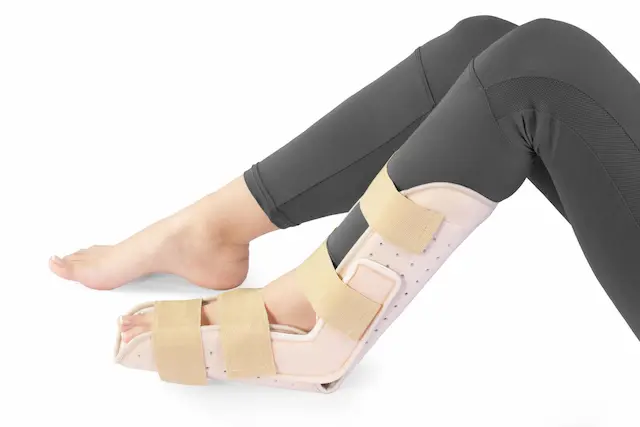Plantar fasciitis brace is a common foot ailment striking athletes and non-athletes alike. The pain often described as a stabbing sensation in the heel, can severely impact daily activities. In this context, plantar fasciitis is a beacon of hope for many. This article delves into the nitty-gritty of this brace, shedding light on its effectiveness types and expert advice. Whether you are a runner a busy professional, or someone who enjoys leisurely walks, understanding how a plantar fasciitis brace can alleviate your pain is crucial.

What is it?
A plantar fasciitis brace is a specialized device designed to alleviate the pain associated with plantar fasciitis. This condition affects the plantar fascia, a thick band of tissue that runs across the bottom of your foot connecting your heel bone to your toes. The brace provides support and slight stretching to the foot, easing the tension in the plantar fascia. By doing so, it helps to reduce inflammation, improve blood circulation, and promote healing. The design of a typical plantar fasciitis brace focuses on comfort and effectiveness, ensuring that wearers can use it throughout the day or night with minimal discomfort.
Why do I have it?
Plantar fasciitis typically arises from repetitive strain injury to the ligament of the sole. Such strain can be excessive running walking, or standing, especially on hard surfaces, wearing inappropriate footwear, or being overweight. Age also plays a role, with the condition more common in those between 40 and 60 years old. Understanding these causes is pivotal in preventing and managing plantar fasciitis. A plantar fasciitis brace can proactively manage symptoms, especially for individuals prone to this condition.
When does it hurt?
Plantar fasciitis pain is most acute during the first few steps after waking up or after long periods of sitting. The pain can also flare up after prolonged periods of standing or when climbing stairs. This pattern is due to the contraction and subsequent sudden stretching of the inflamed plantar fascia. A plantar fasciitis brace helps in these situations by maintaining a slight stretch on the plantar fascia, even when at rest thus reducing the severity of pain experienced during movement.
Experts Advice on Plantar Fasciitis Brace
Experts in foot health often recommend using a plantar fasciitis brace as part of a comprehensive treatment plan for plantar fasciitis. They suggest that the brace should be used with other treatments like physical therapy stretching exercises proper footwear, and, in some cases orthotic inserts. The brace is not a standalone solution but a component of a holistic approach to managing the condition. Consistency in wearing the brace, especially at night, can significantly enhance its effectiveness in relieving pain and promoting healing.
Best Plantar Fasciitis Brace
When selecting the best plantar fasciitis brace, it is essential to consider factors such as comfort adjustability and the level of support provided. An ideal brace should fit snugly but comfortably, offering enough support to the arch and heel without restricting blood flow. Some braces are designed for nighttime keeping the foot at a 90-degree angle, providing a constant, gentle stretch to the plantar fascia.
Ultra Stretch Plantar Fasciitis Splint
The Ultra Stretch Plantar Fasciitis Brace is a popular option for those with plantar fasciitis. It is designed for overnight use. This splint maintains the foot in a dorsiflexed position offering a therapeutic stretch to the plantar fascia. Its adjustable straps and padded lining enhance comfort, making it easier for users to wear it throughout the night. This prolonged stretch helps reduce morning foot pain and contributes significantly to healing.
Phantom Dorsal Night Splint
Another practical choice is the Phantom Dorsal Night Splint. Unlike traditional cumbersome night splints, this plantar fasciitis brace boasts a low-profile design. It is lightweight much less intrusive, and allows for a more relaxing nighttime sleep. Maintaining the foot in an impartial position presents the vital stretch to the plantar fascia, aiding in ache alleviation and recuperation.
Conclusion
In conclusion, the plantar fasciitis brace plays an essential role in dealing with and assuaging the aches caused by Heel pain support. Whether you choose an Ultra Stretch Splint or a Phantom Dorsal Night Splint, it is miles important to remember that those braces are a part of a broader treatment strategy. Regular use with different endorsed remedies can result in extensive enhancements. Remember, every step closer to the proper braces is far from the pain of plantar fasciitis.
FAQs
What is a plantar fasciitis brace and how does it help?
A braces is a supportive device designed to alleviate pain associated with plantar fasciitis. It provides support and a gentle stretch to the plantar fascia the ligament connecting your heel to your toes, thereby reducing inflammation and promoting healing.
When should I wear a plantar fasciitis brace?
It is often recommended for wear during rest periods especially at night. This helps maintain a gentle stretch on the plantar fascia, reducing the intense pain experienced in the morning or after long periods of sitting.
Can a plantar fasciitis brace cure the condition?
While it is significantly alleviating pain and aid in recovery, it is typically used as part of a comprehensive treatment plan. This may include physical therapy, stretching exercises, and proper footwear, among other treatments.
Are there different types of plantar fasciitis braces?
Yes! Various braces include night splints that keep the foot in a dorsiflexed position and daytime braces that offer arch support. Each type serves a different purpose and provides varying levels of support and comfort.
How do I choose the right plantar fasciitis brace for me?
Choosing the right brace depends on your condition’s severity, lifestyle, and comfort preferences. It is essential to consider factors like adjustability support level and whether the brace is for daytime or nighttime use. Consulting with a healthcare professional can also help in making an informed decision.
For More Info… Click Now!